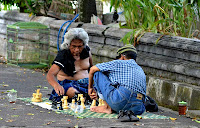 The best possible way to sum up Yogjakarta is that it's cool. It's young, it's trendy, there's fantastic public art, museums, street dancers, musicians and a thriving industry of both authentic and knock-off local arts and crafts (artistic attractions that are often in short supply in Muslim societies).
The best possible way to sum up Yogjakarta is that it's cool. It's young, it's trendy, there's fantastic public art, museums, street dancers, musicians and a thriving industry of both authentic and knock-off local arts and crafts (artistic attractions that are often in short supply in Muslim societies). It's as set-up for tourists as anywhere in Indonesia (outside of Bali) which naturally brings with it all the hassle and annoyance of any touristy place.
It's as set-up for tourists as anywhere in Indonesia (outside of Bali) which naturally brings with it all the hassle and annoyance of any touristy place.You could spend weeks just getting dragged around batik shops (batik is an Indonesian/Malaysian art of painting cloth with odd pipe-like tools). Most batik is dreadfully tacky and overpriced. Fall victim to a smooth-talking member of the batik mafia and you could find yourself back home with a skinny wallet and piece of cloth so ugly it's not even fit for displaying in the basement.
But learn to tune out the noise and Yogja is a rather special place. It's clean (but not sterile), a wander down the less hectic residential lanes is as pleasant as a stroll around the neighbourhoods of Paris (if you can stand the heat). Old men playing chess, kids flying kites, becak (tuk-tuk) drivers enjoying a mid-afternoon siesta and countless flowers in bloom set the scene.
The centre of the city is surrounded by run-down white walls within which lies the 'kraton' - the sultan's palace. The sultan still resides here and it has all the third-world, banana republic charm you would expect. Thanks to a long colonial legacy, the palace is thoroughly European - and much like the colonial administrators must have done, you can visibly see the palace wilting in the tropical sun. Baroque architecture and furniture were not made for the tropics.
The kraton is generally unimpressive, but the east meets west contradictions are thoroughly amusing. The accompanying museum is mind-blowing. Room, after room, after room of dusty cob-webbed furniture (European of course) chipped porcelain dolls, stained wine glasses and . . . dirty oven mitts, sieves and cheese graters - some possibly dating back as far as 1975.
In all seriousness, this may have been the highlight of the trip. Those cheese graters and sieves would be uninteresting if they had belonged to Elvis or the Queen of England - but the Sultan of Yogjakarta? This is a public official so minor that I can't even remember his name.
I've been to a lot of crusty old museums all around the world (Russian museums in particular come to mind) but this was pretty special. We giggled over it the rest of the afternoon.
More on Yogja in the next instalment - negotiating transportation and dodging food-poisoning.



No comments:
Post a Comment